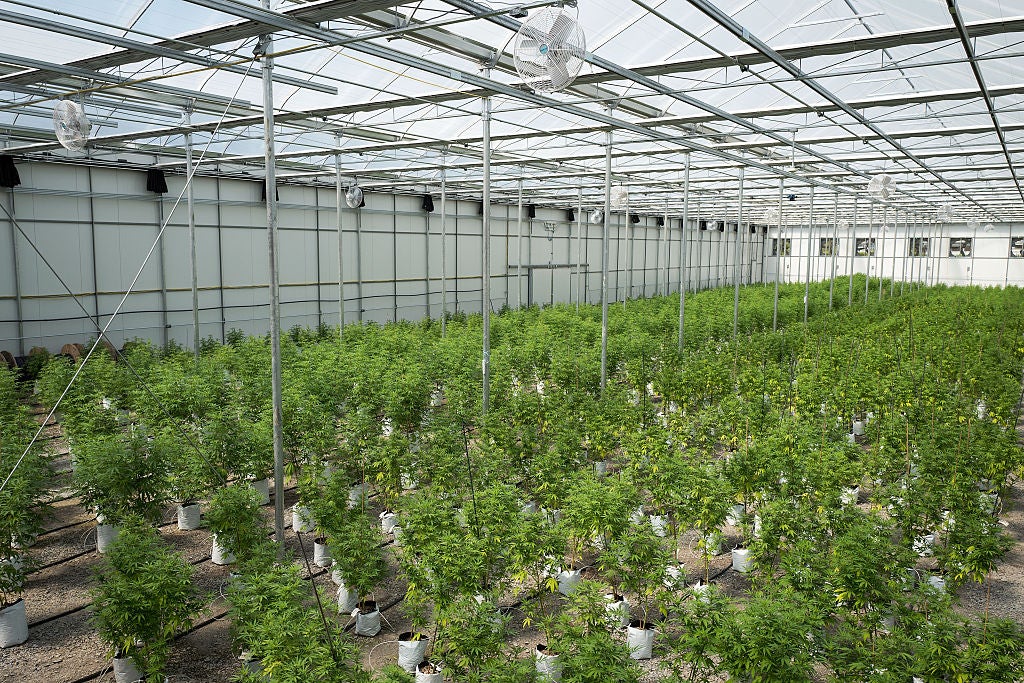Weed is not as green as you think it is
Toxic pesticides from illegal marijuana operations are a known risk to wildlife, writes Louise Boyle, but more research is needed to understand the wider climate and environmental impacts from the booming legal industry


Your support helps us to tell the story
From reproductive rights to climate change to Big Tech, The Independent is on the ground when the story is developing. Whether it's investigating the financials of Elon Musk's pro-Trump PAC or producing our latest documentary, 'The A Word', which shines a light on the American women fighting for reproductive rights, we know how important it is to parse out the facts from the messaging.
At such a critical moment in US history, we need reporters on the ground. Your donation allows us to keep sending journalists to speak to both sides of the story.
The Independent is trusted by Americans across the entire political spectrum. And unlike many other quality news outlets, we choose not to lock Americans out of our reporting and analysis with paywalls. We believe quality journalism should be available to everyone, paid for by those who can afford it.
Your support makes all the difference.This feature was originally published in 2021 and the figures have been updated
It’s 4/20, the unofficial annual holiday of pot smokers and when it comes to getting high, there’s much to celebrate.
Marijuana has been legalized for recreational use in 18 states and the District of Columbia and Guam. The industry is projected could be worth $130 billion a year to the US economy by 2024, with one in ten American adults now saying they smoke weed.
Decriminalizing marijuana not only has economic benefits but advocates view it as a positive step in correcting the institutional racism behind decades of mass incarceration across minority communities for minor drug offenses. A Black person in the US is nearly four times more likely to be arrested for cannabis possession than a white individual, even though cannabis is used at roughly the same rates, according to the Marijuana Policy Project.
What remains relatively unexamined is the environmental cost of cannabis production, both in the legal and illegal markets.
The drug’s history of covert operations means that studies are limited and what research does exist focuses on the US, particularly California.
“The more I dig into this, the more mind-boggling it is how little research has been done on this very broad topic,” Dr Ariani Wartenberg, an agro-ecologist with Berkeley’s Cannabis Research Center at the University of California, told The Independent last year.
In January 2021, Dr Wartenberg co-authored a review of studies documenting links between cannabis and environmental degradation in order to identify gaps in knowledge.
She said: "Research is starting to develop in the US and I’m curious how that will eventually expand internationally. It's still a very taboo topic in research circles outside the US, as far as I know. It's interesting because it's an important crop. I don't think it's going anywhere so we're going to have to deal with it.”
While cannabis crops only make up a small sliver of the agricultural sector, illegal operations are typically tucked away in ecologically-sensitive, remote areas in an attempt to keep them off the radar.
Legalizing pot doesn’t mean that illegal operations, known as “trespass sites”, have disappeared. In Northern California’s Humboldt County alone, there were an estimated 14,000 illegal grow sites in 2018, according to one study. Getting an exact figure on the number of illegal farms is tricky as many are concealed beneath canopies, hidden deep in national forests and on tribal lands.
Trespass sites can have serious adverse impacts on wildlife and water supplies. Plants are often doused with rodenticides and insecticides to prevent them from being eaten by pests and small animals.
At a site in Shasta-Trinity National Forest, north of the Californian city of Redding, authorities discovered that Bromethalin, a neurotoxic rat poison, and carbofuran, a highly toxic, banned insecticide, were in use.
Dr Greta Wengert, a wildlife ecologist from the Integral Ecology Research Center previously told NPR that carbofuran was so toxic that “a quarter teaspoon could kill a 600-pound black bear”.
Evidence has linked toxic rodenticides with increased mortality rates of fishers - an endangered, weasel-like species which live in the forest. Rodenticides have also been discovered in northern spotted owls and barred owls after passing through the food chain. The use of toxic chemicals at illegal marijuana sites also impacted vultures, foxes and bears, a 2017 study found.
When toxic substances are used on hilly cannabis farms, water supplies below are at risk from chemical run-off.
In rural areas, cannabis operations are known to siphon water from streams to irrigate crops, a significant threat to water resources, particularly in a state like California which is facing multi-year, severe “mega drought’. In California alone, these sites have drained more than a billion gallons of water from public water supplies, the US Department of Agriculture reports.
Each marijuana plant needs nearly six gallons of water per day, roughly a gallon more than running one load in an energy-efficient washing machine.
The Forest Service says that it has been using environmental DNA, or eDNA, a sensitive testing method, to detect the presence of cannabis in water to track down illegal sites. The agency also uses a complex algorithm to scan thousands of satellite images to zone in on operations among millions of acres of forest.
Legal weed is not without environmental costs. The growing demand for pot is creating a significant carbon footprint due to the high energy consumption associated with moderating indoor temperature and humidity, and intense, 24/7 lighting.
A study in March 2021 from Colorado State University found that indoor operations , which account for most of the legal cannabis grown in the US, resulted in up to 5,000kg more carbon dioxide emissions, per each kg of dried flower, than outdoor sites.
An earlier study by scientist Evan Mills and the Lawrence Berkeley National Laboratory estimated that cannabis production accounts for 1 per cent of US electricity use.
“One average kilogram of final product is associated with 4600kg of carbon dioxide emissions to the atmosphere, or that of 3 million average US cars when aggregated across all national production,” the paper noted.
Marijuana operations can increase air pollution due to the volatile organic compounds emitted by plants. In high concentrations, VOCs have been linked to health conditions from nausea, fatigue to liver damage and cancer.
Dr Wartenberg told The Independent that policies need to be designed to mitigate increasing environmental impacts, such as encouraging use of energy-efficient light sources and incentivizing precision-irrigation techniques in areas prone to drought. In Humboldt County, local authorities have established a “Retirement, Remediation, and Relocation” program for marijuana growers to combat adverse environmental impacts.
Sustainability initiatives which would reward responsible growers could also be beneficial. For example, the nascent “Sun + Earth Certification” program lets pot smokers know that their cannabis is truly green, and grown in a responsible and sustainable way.
Join our commenting forum
Join thought-provoking conversations, follow other Independent readers and see their replies
Comments